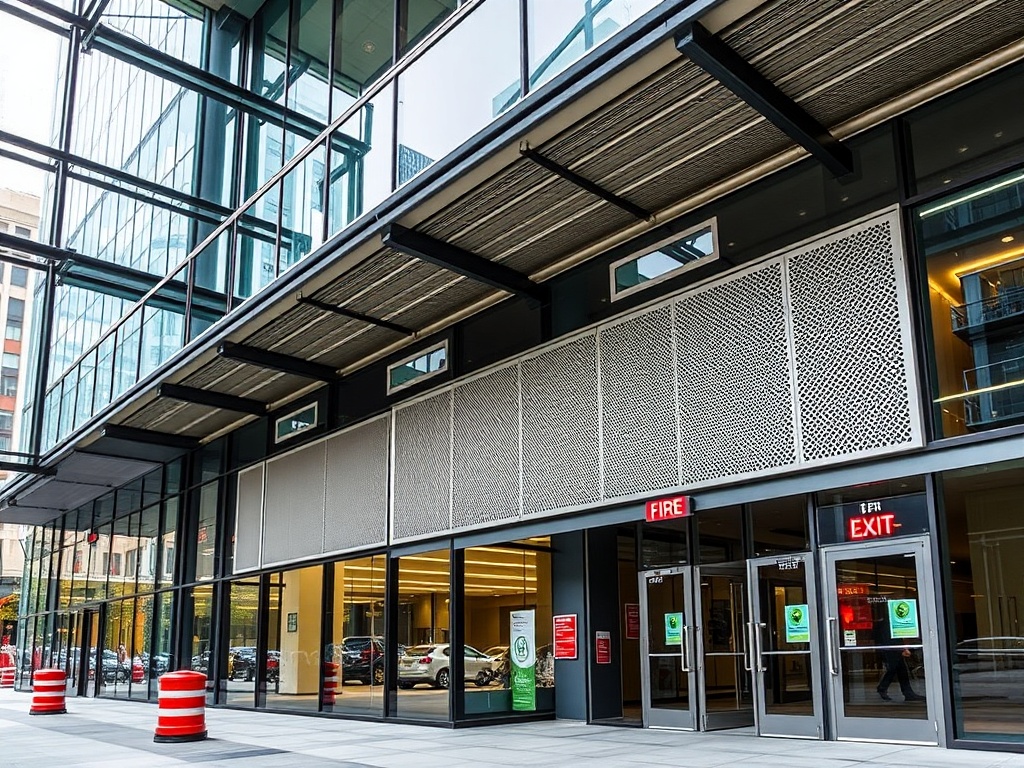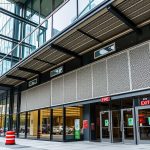Intumescent grilles play a discreet yet vital role in ensuring fire safety in contemporary buildings. These devices allow normal air circulation during everyday use but automatically seal shut under extreme heat, preventing the spread of flames, smoke, and toxic gases. Their ability to function without electricity or mechanical triggers makes them one of the most reliable passive protection solutions available. Modern architecture prioritizes both aesthetic integration and advanced safety systems, and intumescent grilles meet both requirements seamlessly. This article explains how they work, how they interact with ventilation networks, how they complement compartmentation strategies, and why they contribute to durable, low-maintenance fire protection across many building types.
Understanding intumescent technology
A principle of thermal reaction
Intumescent materials are designed to react when exposed to heat. At around 150°C, they expand rapidly and multiply their volume several times, forming a dense insulating char. This expansion completely blocks the opening where they are installed, replacing the normal airflow path with a solid barrier. The protective layer generated during this reaction offers both thermal insulation and mechanical resistance, preventing flames, smoke, and heated gases from passing through grilles or ventilation ducts. This predictable and repeatable chemical reaction is the core of the grille’s effectiveness.
Also to discover : Revamp Your Sheffield Garden: Affordable Ideas for Creating a Welcoming Outdoor Dining Oasis
An automatic fire barrier
The process is entirely autonomous, it requires neither electricity nor a mechanical system. This independence ensures that the grille remains operational even during power failures, which are common in fire events. Once activated, the grille becomes a stable and robust barrier that helps contain the fire within its initial compartment. This passive activation reduces the risk of malfunction and avoids reliance on sensors, controls, or moving parts that may degrade over time. The automatic transformation of the material is instantaneous and guarantees a reliable response even in high-stress environments.
Immediate response at critical temperatures
The material’s rapid expansion ensures swift protection from the very first moments of a fire, which is essential for both occupant safety and structural preservation. In the early stages of a fire, smoke and toxic gases spread quickly and can compromise evacuation routes. Intumescent grilles respond during these crucial seconds by sealing openings before flames can travel through them. This quick activation also reduces the risk of fire propagation through ventilation shafts, walls, and doors areas where traditional fire barriers are often insufficient.
Also to see : Revamp Your Tiny Glasgow Attic into a Snug Book Haven: Ingenious Ideas for Avid Readers
Dual function : ventilation and fire suppression
Maintaining daily airflow
Under normal conditions, intumescent grilles allow air to flow freely. Their open-cell structure ensures efficient ventilation, supporting HVAC systems in distributing fresh air and regulating temperature throughout the building. This dual functionality contributes to comfort, energy efficiency, and overall air quality. By allowing passive airflow without requiring powered components, intumescent grilles reduce the load on mechanical systems while maintaining proper circulation in rooms, corridors, technical spaces, and service ducts.
Automatic sealing in fire conditions
When heat levels rise sharply, the grilles seal completely. This automatic closure prevents flames, smoke, and hot gases from spreading to other areas, reinforcing the building’s fire compartmentation. Because the transformation is triggered purely by temperature, activation occurs exactly where the risk emerges, with no central coordination needed. This localized sealing ensures that the rest of the building remains protected even if the fire originates deep within hidden ventilation paths.
Integration into passive protection strategies
Modern buildings are designed around compartmentalization to contain fire and smoke within limited areas. Products such as wall fire protection grilles fit perfectly into this strategy, allowing airflow between compartments while maintaining fire resistance when required. This integration makes it possible to reconcile two essential needs: constant air circulation for comfort and hygiene, and robust compartment barriers for fire safety. Architects and engineers incorporate these grilles into walls, doors, ceilings, and mechanical rooms to guarantee that ventilation openings do not compromise fire integrity.
Maintaining compartment integrity
In compartmentalized systems, each zone must resist fire for a specific duration typically 30, 60, or 90 minutes. Intumescent grilles ensure this integrity by sealing off ventilation openings in walls, doors, or ceilings whenever high temperatures are detected. Their capacity to transform into a rigid barrier helps maintain the structural fire rating of the compartment they serve. This is particularly important in escape routes, riser shafts, technical rooms, and service corridors where openings are numerous and must be secured.
Versatile applications
These grilles are widely used in residential, commercial, and institutional buildings from offices and hospitals to schools wherever fire safety must coexist with ventilation needs. Their compact format and modular designs allow installation in new constructions as well as renovation projects. They can be integrated into fire doors, partition walls, façade elements, or duct penetrations, making them suitable for a variety of architectural configurations.
Compliance with standards and regulations
Compliance with international standards
Intumescent grilles undergo rigorous testing to meet standards such as EN 1366, EN 13501-2, and UL classifications. These certifications reproduce real fire conditions, assessing resistance to direct flames, rapid temperature rise, mechanical stress, and smoke leakage. Meeting such standards ensures that the grilles will perform reliably when exposed to genuine fire hazards, providing designers and inspectors with measurable, predictable performance criteria.
Mandatory in public and commercial buildings
Regulations often require certified fire-stopping solutions in ventilation systems, especially in public or multi-occupancy buildings such as hospitals, hotels, office complexes, and apartment blocks. Intumescent grilles meet these requirements without complex maintenance or electrical dependence. Their predictable behavior and ease of integration make them a preferred solution for ensuring regulatory compliance in both public and private developments.
Preserving architectural design
Discreet and seamless integration
Intumescent grilles are compact and unobtrusive, unlike mechanical dampers. They fit easily into walls, ceilings, and fire doors without impacting architectural aesthetics. Their slim design allows architects to maintain clean lines, minimal visual clutter, and coherent interiors, even in sensitive design environments such as museums, hotels, high-end residences, or modern office spaces.
Balancing safety and aesthetics
They allow designers to meet fire safety requirements without compromising visual harmony. Because they require no wiring, external components, or visible mechanisms, they remain hidden within the building fabric. This balance between safety and aesthetics is particularly valuable for contemporary architecture, where open spaces and minimalist finishes are increasingly prioritized.
Minimal maintenance and long service life
Passive systems with lasting reliability
As passive devices, intumescent grilles do not rely on motors or electronics. Their effectiveness comes solely from heat-activated expansion, which remains stable over time. Even after years of installation, the material retains its properties, ensuring a dependable response in the event of a fire. Their simplicity also reduces the risk of system failure, making them one of the most reliable components in fire-protection infrastructures.
Durable and economical
Once installed, they require minimal maintenance and offer long-term reliability. Inspections typically involve checking that the openings are not obstructed and verifying that the grille is intact. This ease of maintenance significantly reduces operational costs for building owners and facility managers, making intumescent grilles a financially appealing choice compared with more complex fire-damping systems.
Ideal for renovations and modernization
Practical solutions for existing buildings
Retrofitting fire protection in older buildings can be difficult due to limited space and pre-existing ventilation layouts. Intumescent grilles offer simple installation without major structural alterations. They can be inserted into existing openings, improving fire protection without requiring extensive renovation work. This makes them ideal for heritage buildings, large public facilities, and residential complexes undergoing modernization.
Adaptable to various structures
They can be installed on walls, floors, and doors without altering current ventilation systems. Their modularity allows them to adapt to different thicknesses, materials, and architectural constraints. Whether the project involves concrete walls, gypsum partitions, or metal doors, suitable intumescent grille configurations are available.
Enhancing energy efficiency and air quality
Contribution to sustainability
By enabling natural airflow, these grilles help reduce dependence on energy-intensive mechanical ventilation. They allow buildings to maintain acceptable air renewal rates without constantly running fans or HVAC systems. This makes them consistent with sustainable design approaches, where reducing energy consumption and optimizing passive systems are central goals.
Improved indoor air quality
They allow clean air to circulate under normal conditions while preventing smoke and pollutants from spreading during a fire. This dual behavior supports both daily comfort and emergency safety. In sensitive environments such as hospitals, laboratories, or educational buildings, this ensures a healthier indoor atmosphere and enhanced protection for occupants.
A cost-effective fire safety investment
Affordable and easy to install
Intumescent grilles require no wiring or sensors, making installation simple and economical. They can be mounted directly into walls, doors, or ducts with minimal adjustments. Their low acquisition and installation costs, combined with their long service life, provide excellent value for both small projects and large-scale developments.
Proven performance
Despite their minimal design, they meet strict fire resistance standards and provide consistent protection throughout their service life. Their predictable behavior under extreme heat makes them a trusted component of long-term fire protection strategies.
Choosing the right intumescent grille
Key selection criteria
Consider fire resistance rating, installation location, and certification when choosing a model. The required fire-resistance period should always correspond to the rating of the compartment being protected. The grille’s airflow capacity, compatibility with wall materials, and structural constraints should also be evaluated during the design phase.
Work with reliable manufacturers
Partnering with reputable suppliers ensures regulatory compliance and long-term reliability. Quality manufacturers also provide technical documents, installation guides, and performance certifications that simplify approval processes and guarantee correct integration into the building’s fire-protection structure.
Reliability and safety without moving parts
The absence of mechanical components reduces failure risks. Intumescent grilles operate automatically even during power outages. Their passive nature ensures permanent readiness without regular servicing or testing procedures required by motorized dampers. This reliability allows building managers to count on consistent protection with minimal operational oversight.
Suitable for all building types
They are used in residential buildings, industrial environments, and healthcare facilities due to their versatility. Whether installed in small apartments, large factories, data centers, or public institutions, they offer a consistent level of protection adapted to each environment’s specific risks and ventilation needs.
Intumescent grilles provide efficient passive fire protection by allowing airflow in daily use and sealing instantly during a fire. Compact, durable, and compliant with global standards, they are a key element of modern fire safety strategies. Their combination of economy, reliability, aesthetic discretion, and long-term performance makes them an essential component of any comprehensive fire-protection plan.



